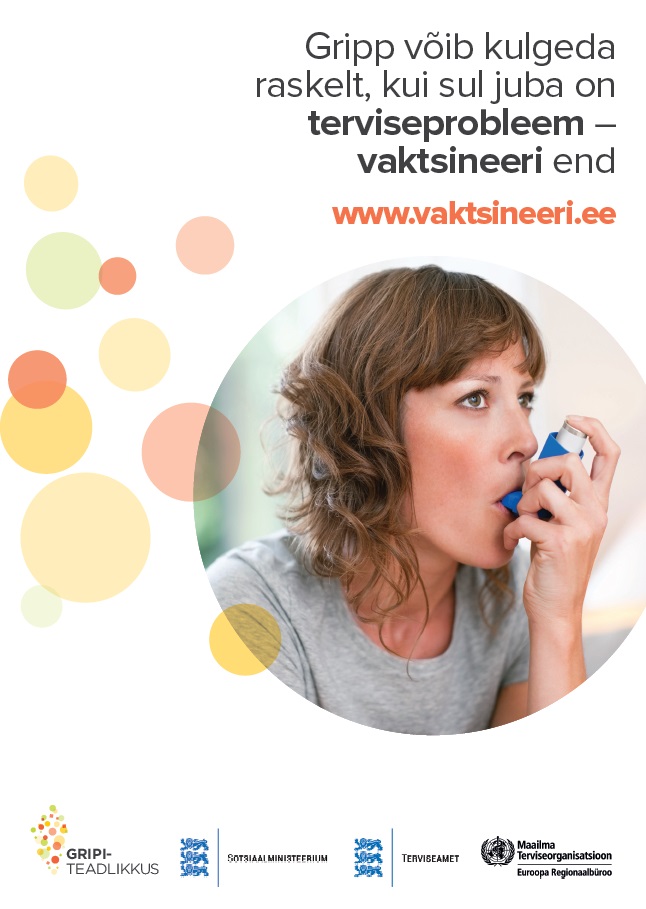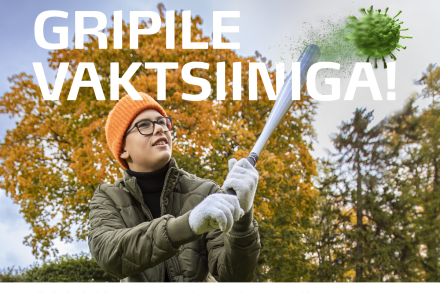Influenza (the flu) is a serious contagious disease of the respiratory tract. According to experts of the WHO and the ECDEC, there are 40,000–220,000 flu-associated deaths across the world every year and about 5–15% of population gets the flu during each flu seasons.
It is best to get vaccinated against the flu prior to the peak flu season, from October to December. Immunity will develop within two weeks after vaccination.
Vaccinations are conducted by healthcare workers who have received relevant training. In order to get a vaccination injection, turn to your family physician or to a vaccination office.
Symptoms of the flu:
- Sudden onset of the disease.
- High fever (38°C and above).
- Chills and fatigue.
- Coughing, headaches, throat or muscle pain, difficulties breathing.
- Diarrhoea may also occur.
Flu treatment:
- A better alternative is to prevent the flu by getting vaccinated.
- However, if you have contracted the flu, getting some rest and drinking adequate amounts of liquids will help.
- Fever and muscle pain can be treated with regular over the counter medicine available at pharmacies. It usually takes about a week to get better.
- When sick, avoid going to work or school, spending time with young children and visiting crowded venues.
- Your doctor will prescribe antiviral medicines for you to recover from the flu. Antibiotics are of no help for treating the flu.

The flu season generally lasts from October to May. The flu virus usually reaches high numbers at the end of December or beginning of January, cases of flu are registered until the end of May.
The flu usually starts with a high fever and muscle pain, and is a considerably more serious disease when compared to those listed below, as it can lead to complications such as pneumonia, kidney infection or exacerbation of chronic diseases. As a rule, type A flu spreads faster and is more acute.
Parainfluenza (para flu) usually starts with throat pain, followed by rhinitis and barking cough. Muscle pain, which is characteristic of flu, can also occur. Para flu does not pass within a week, it takes longer to recover. There is no special medication just for para flu.
Symptoms of adenovirus are similar to those of other respiratory tract diseases. In addition, eye infection, indigestion and abdominal pain may occur. People have also referred to this virus as ocular or stomach flu, but those are not actual illnesses.
The RS virus manifests in a cough, which can lead to asthmatic symptoms and even put a child at risk of asphyxiation.
People who are in flu risk groups should seriously consider getting vaccinated; the risk groups include:
- people who are 65 years old and older;
- people with anemia, chronic lung, cardiac, renal or metabolic diseases (in particular diabetes);
- children and adolescents aged 6 months to 17 years who are getting longterm aspirin treatment;
- people with immunodeficiency, including those receiving immunosuppressive therapy and HIVpositive people;
- pregnant women during all three trimesters;
- patients with chronic diseases in care facilities and longterm hospitals;
- people who are at risk due to their occupation (health care workers, care workers, poultry farm employees, etc.);
- people who may spread the flu to a risk group (e.g. people who actively come into contact with those aged 65 years and above).
In pregnant women, the flu may take on a more severe course of illness and cause serious complications. During pregnancy, temporary changes occur in the functioning of the immune system, heart and lungs, which can cause pregnant women to have the flu in a more acute form than others. When contracting the flu, pregnant women are more likely to be hospitalized and die. Flu puts the unborn child at risk of premature birth and being underweight at birth.
Vaccination with seasonal influenza vaccine is a safe and beneficial choice in all stages of pregnancy. Millions of pregnant women across the world are vaccinated with seasonal influenza vaccine every year and this vaccine is safe for them. After vaccination, maternal immunity is passed on to the child, thereby protecting the child during the first six months of its life. As children of this age are not vaccinated against the flu, protection from the mother is the fastest way for the child to get the necessary antibodies.
Common side effects of vaccination are pain and swelling at the injection site. Some people may also experience headaches, muscle pain, fever, fatigue or nausea. These side effects are mild and pass quickly.
The flu is transmitted from person to person by direct contact in the form of aerosol transmission. Therefore, a sick person should always, when sneezing or coughing, cover their mouth and nose with a clean tissue, which should be thrown to the trash right after use. In the absence of a tissue, you can also cover your mouth with the end of your sleeve. This reduces the spread of the virus.
The flu virus will remain contagious:
- 24–48 hours on hard surfaces;
- 8–12 hours on porous materials (clothes, paper);
- up to 5 minutes on hands contaminated with the virus (up to 3 hours in the case of massive contamination).
The most effective protection is provided by vaccination at the start of the peak flu season (October–December). In healthy people, the influenza vaccine will take effect 10–14 days after injecting and the effect will last for up to a year. All those who have no contraindications to influenza vaccine can get vaccinated from the age 6 months and up.
Vaccination is contraindicated in case of hypersensitivity to egg protein or any of the other vaccine components, as well as during acute febrile illness.
Additional prevention methods:
- Avoiding contact with people who are ill; in the case of having fallen ill, avoiding contact with others.
- Avoiding large crowds, shaking hands and other close contacts (less than 1 meter).
- Staying at home from work or school when you have fallen ill.
- When sneezing or coughing, cover your mouth and nose with a paper tissue, after which throw the tissue into the trash right away. If you don’t have a tissue at hand, you can cover your mouth and nose with the end of your sleeve.
- Washing hands with soap and water or a disinfectant that contains alcohol (especially after coughing or sneezing).
- Avoiding touching the eyes, nose and mouth. The flu is often spread by touching items covered with germs and then touching your eyes, nose or mouth.
- Healthy lifestyle. Sufficient sleep, physical activity, avoidance of stress, and adequate consumption of liquids and nutritious foods.
- Avoiding the use of public transport during the peaks flu season.
The following link contains instructions on how employers can reduce the risk of workers’ exposure to the flu, prevent the spread of flu and ensure the company's work capability: Flu-related recommendations to employers.
The following link contains instructions on how managers and educators of childcare facilities can reduce the risk of students and employees contracting the flu, and how to prevent the flu from spreading: Recommendations for the organisation of work (in relation to the flu) at schools and pre-school establishments.





